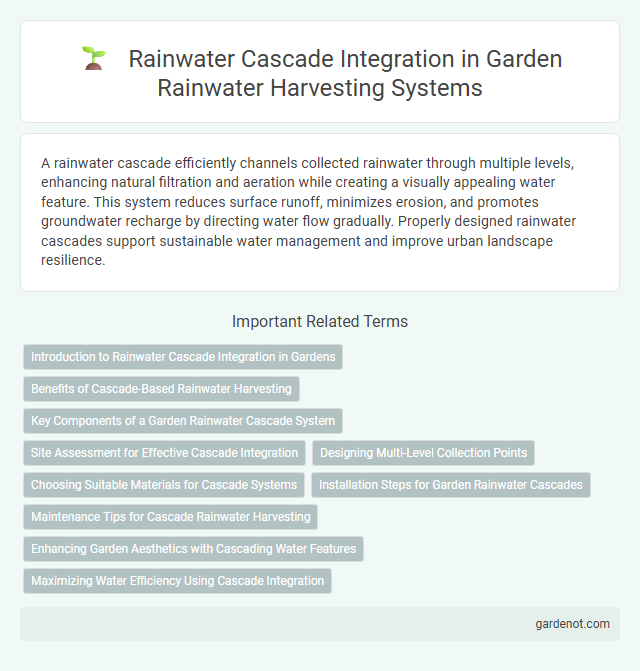A rainwater cascade efficiently channels collected rainwater through multiple levels, enhancing natural filtration and aeration while creating a visually appealing water feature. This system reduces surface runoff, minimizes erosion, and promotes groundwater recharge by directing water flow gradually. Properly designed rainwater cascades support sustainable water management and improve urban landscape resilience.
Introduction to Rainwater Cascade Integration in Gardens
Rainwater cascade integration in gardens enhances water conservation by channeling collected rainwater through a series of tiered basins or steps, mimicking natural water flow. This method not only reduces runoff and soil erosion but also promotes groundwater recharge and supports plant hydration efficiently. Designed with sustainable landscaping principles, rainwater cascades improve water management while adding aesthetic value to garden spaces.
Benefits of Cascade-Based Rainwater Harvesting
Rainwater cascade systems enhance water collection efficiency by channeling runoff through multiple stages, increasing filtration and reducing sediment buildup. These cascades improve groundwater recharge and minimize soil erosion, promoting sustainable water management in urban and agricultural settings. Implementing cascade-based rainwater harvesting supports ecosystem health by maintaining local water cycles and reducing dependency on municipal supplies.
Key Components of a Garden Rainwater Cascade System
A garden rainwater cascade system typically includes a catchment area, such as a rooftop, to collect rainwater, connected to a series of stepped basins or reservoirs that facilitate controlled water flow and filtration. Key components also involve gutters and downspouts that channel water from the roof, along with overflow outlets and perforated pipes to regulate distribution and prevent flooding. Integrating a pumping mechanism or gravity-fed system ensures efficient water movement through the cascade, supporting garden irrigation and enhancing water conservation.
Site Assessment for Effective Cascade Integration
Site assessment for effective rainwater cascade integration involves analyzing topography, soil permeability, and rainfall patterns to optimize water capture and flow management. Identifying natural slopes and drainage paths ensures the cascade directs water efficiently through successive storage or infiltration points. Detailed evaluation of vegetation cover and existing infrastructure supports sustainable design, minimizing erosion and maximizing harvested rainwater retention.
Designing Multi-Level Collection Points
Designing multi-level collection points in rainwater cascades maximizes water capture by channeling runoff through sequential reservoirs or tanks placed at different elevations. This approach optimizes gravitational flow, reduces overflow risk, and enhances storage efficiency. Materials like concrete, stone, or modular plastic containers are often used to create durable and scalable cascade systems tailored to various landscapes.
Choosing Suitable Materials for Cascade Systems
Selecting suitable materials for rainwater cascade systems is essential to ensure durability, water quality, and efficient flow. Non-toxic, corrosion-resistant materials such as stainless steel, high-density polyethylene (HDPE), and UV-stabilized polymers are ideal for preventing contamination and withstanding weather conditions. Smooth surfaces and properly sealed joints minimize leakage and promote consistent water movement in cascade channels.
Installation Steps for Garden Rainwater Cascades
Installation of garden rainwater cascades begins with selecting a suitable location that ensures optimal water flow from rooftop gutters or downspouts. Securely mount cascade tiers or basins, typically made from durable materials like stone or metal, in a stepped arrangement to facilitate smooth water movement and prevent overflow. Connect the cascade system to rainwater collection points with appropriate piping or channels, incorporating filters to remove debris, and ensure proper drainage to maintain garden irrigation efficiency.
Maintenance Tips for Cascade Rainwater Harvesting
Regular inspection of the rainwater cascade system prevents blockages by removing debris and sediment buildup from channels and filters, ensuring smooth water flow. Periodic cleaning of catchment surfaces and downspouts reduces contamination and maintains water quality for storage. Installing mesh screens and checking for structural damage after heavy rains prolongs the system's durability and efficiency.
Enhancing Garden Aesthetics with Cascading Water Features
Rainwater cascades create visually stunning garden aesthetics by channeling harvested water through tiered features that mimic natural waterfalls, promoting tranquility and elegance. These cascading water elements not only enhance outdoor spaces but also improve water circulation and oxygenation for nearby plants, supporting garden health. Integrating rainwater harvesting systems with cascades maximizes sustainable water use while elevating the sensory appeal of landscape designs.
Maximizing Water Efficiency Using Cascade Integration
Rainwater cascade systems maximize water efficiency by sequentially channeling collected rainwater through multiple filtration and storage stages, enhancing water quality and storage capacity. Integrating cascade designs in rainwater harvesting improves runoff capture while reducing overflow and water loss, optimizing usage for irrigation and non-potable applications. This method leverages gravity flow and tiered retention, ensuring consistent water availability and sustainable resource management.
Rainwater cascade Infographic

 gardenot.com
gardenot.com